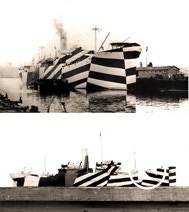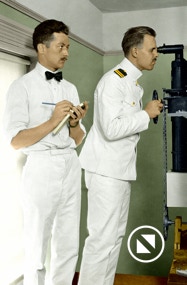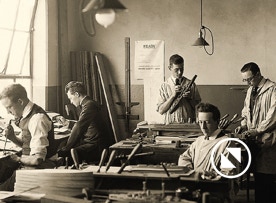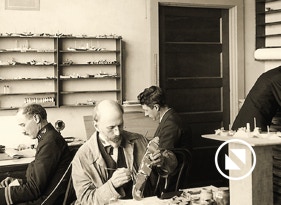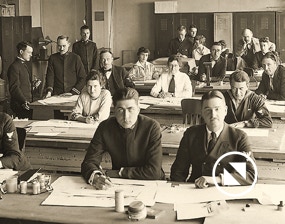
PROCESS
Based on research by
Roy R. Behrens, as published in FALSE COLORS: Art, Design and Modern Camouflage (2002); CAMOUPEDIA: A Compendium of Research of Art, Architecture and Camouflage (2009); and SHIP SHAPE: A Dazzle Camouflage Sourcebook (2012)
An unnamed American camoufleur in the Christian Science Monitor, 1919—
[Painting a ship] was no place for a dainty man, for a rain of things descended on us. Bolts, hot rivets, scraps of iron, and heavier things like lumps of wood and heavy pieces of rope…A camoufleur is not a camoufleur unless he falls overboard regularly once a week.
Above At top is the USS Mahomet in its dazzle camouflage, designed by artist Frederick Judd Waugh. Below that is the model used in assessing its effectiveness.
Note All photographs on this page are US Government images in public domain, c1918. All have been digitally restored, cropped and sepia-toned (or otherwise digitally colored).
•••

THE PHOTOGRAPHS on this page are views of the typical stages in the design of WWI ship camouflage.
STEP ONE was to devise a potentially effective scheme in light of what was known about U-boats, periscopes, and torpedoes. Critical to this process was to comprehend the problem, since a misunderstanding of what was needed could forestall an effective solution. Early in WWI, the question that was typically asked was How can we conceal a ship? In 1917, when that was replaced by the question of How can we prevent a ship from being struck by a torpedo?, the goal of naval camouflage changed from low visibility to course deception.
STEP TWO [follow red numbers] involved the construction of small-scale model ships, to which designs could be applied and tested. A few were made from plaster, but most were assembled (somewhat crudely) from scraps of wood, wire and nails. The largest US models measured about twenty-two inches, while others were much smaller. Once assembled (as recalled by Everett L. Warner) a ship model was “turned over to a designer, who studied its peculiarities and, [in STEP THREE] after applying a tentative plan, carried it into the testing theatre for further study.”
STEP FOUR was an assessment of the effectiveness of the camouflage scheme. In the testing theatre, the ship model was placed on a turntable (with degree markings) controlled by an observer, who viewed it through a periscope, against a painted background, in simulated lighting. By asking naval personnel to estimate the angle of the model’s course, a numerical value could be reached of the likelihood of error. Those which caused the greatest mistakes were sent on to the drafting room.
CAMOUPEDIA
The step-by-step process involved in designing and applying ship camouflage during World War I


Richmond Knapp Fletcher [civilian naval camoufleur] quoted in Harvard Class of
1908: Secretary’s Third Report. April 1920, pp. 170-171—
The camoufleur’s principal job was to superintend the marking off and painting of the ships, following designs sent out by the Navy Department. When not thus engaged, we worked at new designs on small ship models, studying them in a marine theatre equipped with a periscope lens. A complete knowledge of the theory of these designs was essential, since the design supplied for any given ship seldom fitted the ship exactly, which meant that a certain amount of originality and initiative was necessary in marking off a vessel. This work was generally done in a hurry, between the docking and sailing of a ship. We often worked from 7 am until 9 pm with perhaps five or ten minutes for meals. It was a continuous round of exercise on rope ladders, “bosun’s chair,” swinging stages, scaffolds, and up and down ropes hand over hand. We lived in an atmosphere of grease, steam, coal and dust, and everywhere, wet paint. It was exciting while it lasted…
STEP FIVE required camoufleurs to transfer a ship model’s camouflage scheme to full-color construction plans (like blueprints), which, when finished, were reproduced in multiples as large lithographic prints by the US Geological Survey. These were then distributed to teams of artists at various US shipping yards, who used the plans for STEP SIX, the painting of the actual ships.

